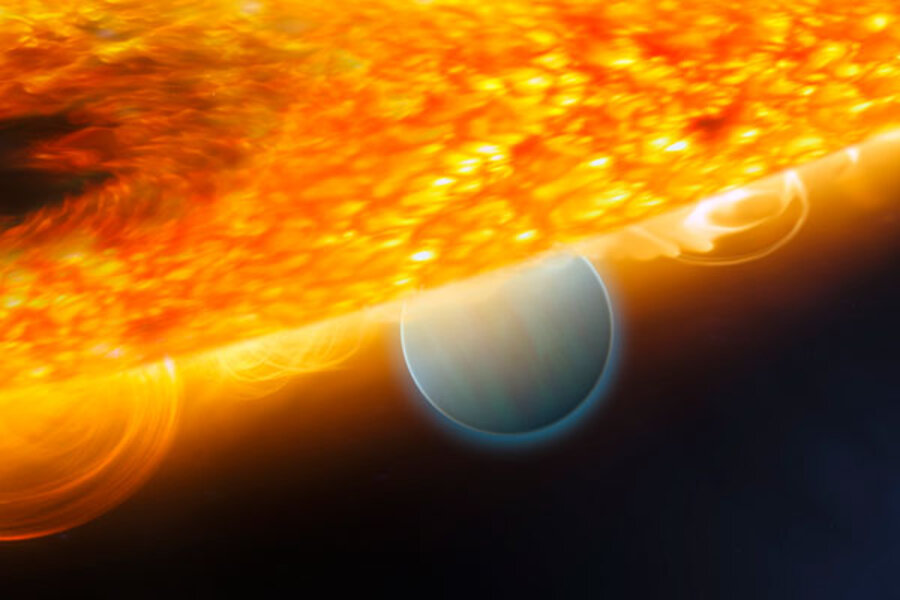Planetary wrecking balls: how Jupiter might have destroyed Earth
Loading...
It's lonely, being a hot Jupiter.
But that seems to be the lot for Jupiter-scale extrasolar planets orbiting within a whisker of sun-like stars, according to a new study. It shows that such planets are likely to be the only surviving children of their host star.
The work not only sheds light on how such systems form, it also gives humans one more reason to appreciate their own Jupiter. Had the solar system's largest planet followed the same developmental process that hot Jupiters apparently have, Earth would have been either pulverized or sent hurtling into interstellar space.
“That would be bad for us,” observes Jason Steffen, a researcher at the Fermi National Accelerator Laboratory's Center for Particle Astrophysics in Batavia, Ill.
While finding an Earth-mass planet in a star's so-called habitable zone remains the holy grail of efforts to detect extrasolar planets, studying oddballs such as hot Jupiters provides insights into the processes that create the wide range of solar-system configurations researchers have so far uncovered.
The study, published Monday in the Proceedings of the National Academy of Sciences, aimed to answer a question astronomers and astrophysicists have been asking since the first hot Jupiter was discovered in 1995: How do such systems wind up with that configuration?
Gas giants orbiting other stars at distances that would fall well inside of Mercury's orbit were the first extrasolar planets discovered. Because of their mass and their close-in orbit, hot Jupiters' effects on their parent stars are more pronounced than in other systems. Once researchers had identified these planets as gas giants, the chin-scratching began.
In our solar system, Jupiter and the other outer gas planets formed beyond what researchers have dubbed the solar system's frost line: a region in the early sun's disk of dust and gas where water, ammonia, methane, and other hydrogen-bearing compounds freeze into ice grains. Inside the frost line, the rocky planets formed.
Two competing scenarios emerged to explain how Jupiter-like gas giants migrated inward. The new report has led one team member to come to a definitive conclusion in the debate.
The earliest explanation suggested that a hot Jupiter forms beyond the frost line, but gravity from a passing star, or perhaps another massive companion planet, kicks the Jupiter into a highly elliptical orbit around its star. Each time the planet passes close to the star, its orbit is gradually reshaped until the orbit is far less elliptical orbit and so close that its “year” can be as fast as 19 hours.
According this explanation, the hot Jupiter would have destroyed or ejected any planetary munchkins within its orbit as the orbit evolved.
More recently, scientists have posited that Jupiter-class planets could simply migrate inward through the disk of dust and gas surrounding a young star. Under one scenario, it would get so close that it would induce tides on its star, similar to the tides the moon sets up on Earth's seas. In effect, that stellar “high tide” would transfer enough energy back to the planet's orbit to stabilize it and keep the planet from falling into the star.
According to this explanation, lower-mass planets could survive in the hot Jupiter's general region.
When the team hunted for evidence of additional planets in the 63 hot-Jupiter systems it studied, it found none.
“I was a bit surprised there were none in the sample,” says Steffen, who was the lead author of the PNAS paper reporting the results.
Throughout much of the 2000s, the migrate-through-the-disk explanation dominated, suggesting that with the right data, additional planets could be found. The results of this study provide a fairly definitive case that the earlier explanation is the right one, Steffen says.
But the team found that companion planets did survive in cousins of the hot-Jupiter system. For example, it studied 224 systems with so-called hot Neptunes – lower-mass gas giants with orbits comparable to those of the hot Jupiters. In addition, they studied 31 systems with so-called warm Jupiters – Jupiter-mass gas giants with orbital periods that signaled wider orbits that those traveled by the hot Jupiters.
In those systems, the team in some cases found evidence for companion planets, including some that appeared tightly bunched.
One-third of the hot Neptunes showed evidence of companions, suggesting that hot Neptunes may not have been massive enough to disrupt the formation of other, smaller planets, says Alan Boss, a researcher at the Carnegie Institution of Washington's Department of Terrestrial Magnetism who focuses on extrasolar planets and took part in the study.
With warm Jupiters "a few lower-mass planets can still form and survive, though the exact reason why this differs from the hot Jupiter case is unclear,” he writes in an e-mail exchange.
The work raises an overarching question for our solar system, Steffen concludes: “Why didn't our Jupiter become one of these hot Jupiters?” The clear indication is that at some stage a hot Jupiter gets kicked into a highly elliptical orbit. But the details of how it got there? No one has the definitive answer for that yet, he says.







